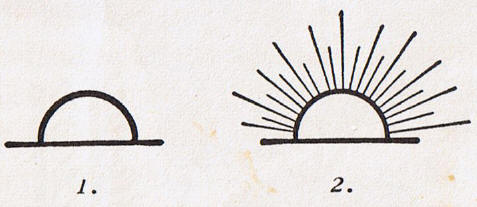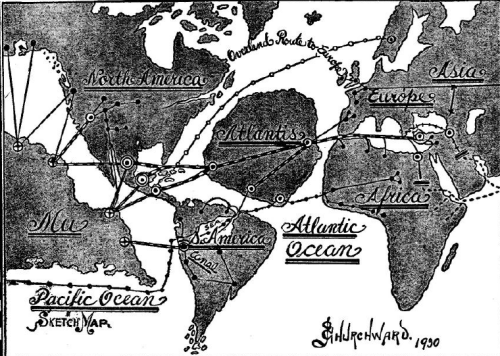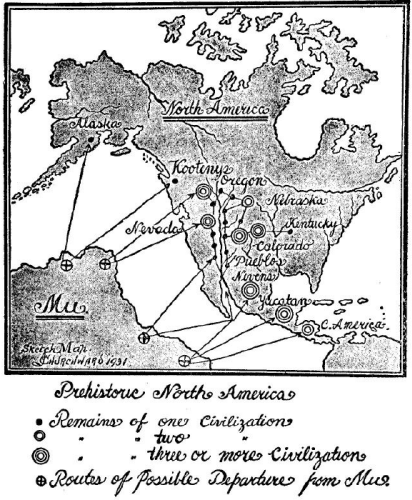|
CHAPTER II
When Mu, the Motherland, became overcrowded, or, among her great navigators, some ambitious and enterprising company found new and available lands, a colonial development was started.
These emigrant children of Mu were called Mayas. All who left the Motherland in any direction were called Mayas. Colonization must have started at least 70,000 years before Mu sank, for there are Naacal writings in the Orient stating that the Holy Brothers carried the religion and the sciences of the Motherland to the colonies "over 70,000 years ago."
One of these colonies was said to "have
a population of 35,000,000 people."
From these remains it is very clearly shown that two main directions of colonization were followed, with many branches from the main lines, and many independent short lines. The two main directions were east and west from Mu. I have found no records showing which of these directions was first commenced, or the approximate date when Mu's first colony was established.
The date of only one colony is to be found so far, the Maya Colony on the Nile Delta in Egypt, which was set-tied about 16,000 years ago. Records point to the possibility that the first colonies on each of the main lines were started at about the same time. We know definitely, however, where the first colonies were started. In an easterly direction settlements were made on what are now the West Coasts of North and Central America. Westerly colonization first took place on the Eastern Coast of Asia.
A symbol was assigned for the colonies: the sun rising on the horizon without rays. (Fig. 1.)
When a colony had advanced far enough to govern itself under the suzerainty of the Motherland it was turned into a Colonial Empire, and a ruler appointed. Its symbol was the sun with rays rising on the horizon. (Fig. 2.)
The ruler had the title "Son of the Sun"
bestowed upon him by the Motherland, which meant that he was a
subject or son of Mu, "The Empire of the Sun."
The accompanying map will show the lines
taken by the various colonists from Mu in an easterly direction.
From the west coast of America a branch ran down the west coast of South America, traceable as far as Chile. From the east coast of Central America a branch ran down the east coast of South America, traceable as far as Argentina. Another branch ran to the north and east, ending in Scandinavian Europe. From Atlantis branches ran to southwestern Europe and northwestern Africa. Along the Mediterranean, branches were thrown out north and south.
The last of these Mediterranean colonies
was the Nile Delta, Lower Egypt.
They still have distant cousins in the
Pacific occupying Melanesia (the southwestern Pacific Islands). In
addition to the black line there was a white race known as the Caras
or Carians who are the Greeks today.
They are found on the top of the Andes
Mountains near Lake Titicaca.
I have drawn a free-hand conventional map of North and Central America showing approximately where remains of prehistoric civilizations have been found.
Single circles show one civilization only; two circles where two have been found, and three circles where three or more civilizations can be seen. Remains of extremely ancient people are found from Alaska to Cape Horn.
One prominent fact stands out boldly:
This I will take up later. Remains of three or four civilizations are found in our western states.
All but one are shown to have been destroyed by cataclysms and the remaining one was destroyed by the raising of our western mountain ranges. Utah, Nevada, New Mexico, Arizona, Colorado, Mexico and Central America afford the archaeologist of today one of the most prolific fields to work in.
Nowhere else on earth is there such an abundance of varying material for him to study. Not only this, but some of the oldest records of man are to be found among this archaeological wealth, dating far back into the Tertiary Era with some few cases probably extending back as far as the Miocene Period. These remains are hoary with age.
There they stand awaiting intelligent, sympathetic, believing students who will listen to their tales and truthfully recount what is told.
The student must read the writings on their wrinkled and weathered faces and interpret them intelligently. They are too old and venerable to be bluffed into giving up their secrets. The student must come to them with an open mind, capable of receiving what they tell him. He must come to them knowing their language and their alphabet.
The evidences which tell of these
civilizations vary from flint arrow and spear heads to exquisite
pottery, jewelry and paintings, even to great cities built of
concrete and stone.
The Quetzals, who were the first people to occupy any part of North or Central America, have left nothing but traditions behind them, unless some of the oldest remains of man which have been found belong to the Quetzals without our knowing it, which is quite possible.
In the
Lost Continent of Mu, I gave a
few out of the many legends about the Quetzals to which an
additional note is added here.
Their language is Maya and they claim
that they are the descendants of those who fled to the forests when
their King Quetzal was conquered and overthrown.
Very few writers on Yucatan have said anything about the Pygmies.
Yet they must have been an important
little people judging by what they have left behind, for all along
the coast line of eastern Yucatan and on many of the islands lying
off the coast are to be seen their houses and little temples. Among
the natives of this region are found many legends about the Pygmies
who once lived there, and not so very long ago.
The question is, are they all extinct in America?
I am told not, for when I was in British Honduras I was informed that hunters and explorers occasionally meet them back in the dark valleys of the mountains. They are about three feet tall with dark complexions and an abundance of very long black hair.
It is said that they speak the Maya
tongue fluently.
|


